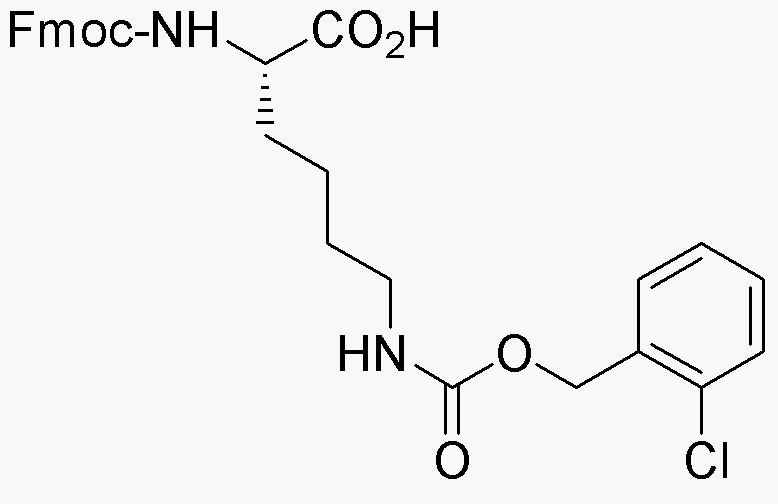Na-Fmoc-Ne-2-chloro-Z-L-lysine is widely utilized in research focused on:
- Peptide Synthesis: This compound serves as a key building block in the synthesis of peptides, particularly in solid-phase peptide synthesis, allowing for the creation of complex and functional peptides.
- Drug Development: It plays a significant role in the pharmaceutical industry for developing peptide-based drugs, enhancing the efficacy and specificity of therapeutic agents.
- Bioconjugation: The chemical is used in bioconjugation processes, enabling the attachment of biomolecules to drugs or imaging agents, which is crucial in targeted therapies.
- Research in Protein Engineering: Researchers utilize it to modify lysine residues in proteins, facilitating studies on protein structure and function, and improving protein stability.
- Development of Diagnostic Tools: Its application in creating peptide probes aids in the development of diagnostic tools, enhancing detection methods in various medical fields.
General Information
Properties
Safety and Regulations
Applications
Na-Fmoc-Ne-2-chloro-Z-L-lysine is widely utilized in research focused on:
- Peptide Synthesis: This compound serves as a key building block in the synthesis of peptides, particularly in solid-phase peptide synthesis, allowing for the creation of complex and functional peptides.
- Drug Development: It plays a significant role in the pharmaceutical industry for developing peptide-based drugs, enhancing the efficacy and specificity of therapeutic agents.
- Bioconjugation: The chemical is used in bioconjugation processes, enabling the attachment of biomolecules to drugs or imaging agents, which is crucial in targeted therapies.
- Research in Protein Engineering: Researchers utilize it to modify lysine residues in proteins, facilitating studies on protein structure and function, and improving protein stability.
- Development of Diagnostic Tools: Its application in creating peptide probes aids in the development of diagnostic tools, enhancing detection methods in various medical fields.
Documents
Safety Data Sheets (SDS)
The SDS provides comprehensive safety information on handling, storage, and disposal of the product.
Product Specification (PS)
The PS provides a comprehensive breakdown of the product’s properties, including chemical composition, physical state, purity, and storage requirements. It also details acceptable quality ranges and the product's intended applications.
Certificates of Analysis (COA)
Search for Certificates of Analysis (COA) by entering the products Lot Number. Lot and Batch Numbers can be found on a product’s label following the words ‘Lot’ or ‘Batch’.
*Catalog Number
*Lot Number
Certificates Of Origin (COO)
This COO confirms the country where the product was manufactured, and also details the materials and components used in it and whether it is derived from natural, synthetic, or other specific sources. This certificate may be required for customs, trade, and regulatory compliance.
*Catalog Number
*Lot Number
Safety Data Sheets (SDS)
The SDS provides comprehensive safety information on handling, storage, and disposal of the product.
DownloadProduct Specification (PS)
The PS provides a comprehensive breakdown of the product’s properties, including chemical composition, physical state, purity, and storage requirements. It also details acceptable quality ranges and the product's intended applications.
DownloadCertificates of Analysis (COA)
Search for Certificates of Analysis (COA) by entering the products Lot Number. Lot and Batch Numbers can be found on a product’s label following the words ‘Lot’ or ‘Batch’.
*Catalog Number
*Lot Number
Certificates Of Origin (COO)
This COO confirms the country where the product was manufactured, and also details the materials and components used in it and whether it is derived from natural, synthetic, or other specific sources. This certificate may be required for customs, trade, and regulatory compliance.


